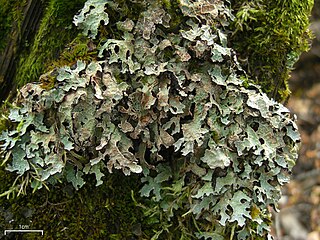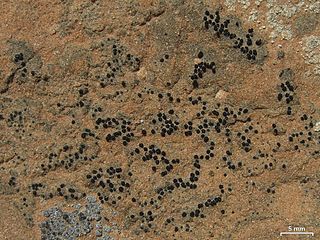
Parmelia is a genus of medium to large foliose lichens. It has a global distribution, extending from the Arctic to the Antarctic continent but concentrated in temperate regions. There are about 40 species in Parmelia. In recent decades, the once large genus Parmelia has been divided into a number of smaller genera according to thallus morphology and phylogenetic relatedness.

The Parmeliaceae is a large and diverse family of Lecanoromycetes. With over 2700 species in 71 genera, it is the largest family of lichen-forming fungi. The most speciose genera in the family are the well-known groups: Xanthoparmelia, Usnea, Parmotrema, and Hypotrachyna.

Notoparmelia is a genus of foliose lichens in the family Parmeliaceae. It includes 18 species that grow on bark and rocks, and are mostly distributed in the Southern Hemisphere. The genus was created in 2014 as a segregate of Parmelia.
Xenonectriella nephromatis is a species of lichenicolous fungus in the family Nectriaceae. Found in Alaska, it was described as a species new to science in 2020 by Sergio Pérez-Ortega. The type specimen was discovered in the Hoonah–Angoon Census Area in Glacier Bay National Park, where it was growing on a Nephroma lichen. The specific epithet alludes to this host lichen.
Xenonectriella subimperspicua is a species of lichenicolous fungus in the family Nectriaceae. It has been recorded from South America, Europe, and New Zealand.
Sclerococcum fissurinae is a species of lichenicolous fungus in the family Dactylosporaceae. Found in Alaska, it was formally described as a new species in 2020 by Sergio Pérez-Ortega. The type specimen was collected in the Hoonah-Angoon Census Area, just outside of Glacier Bay National Park. Here it was found growing on the script lichen species Fissurina insidiosa, which itself was growing on the bark of an alder tree. The specific epithet refers to its host.

Parmelia barrenoae is a species of foliose lichen in the large family Parmeliaceae. It was formally described as a new species in 2005. Before this, it was lumped together as one of several lichens in the Parmelia sulcata group—a species complex of genetically distinct lookalikes. Parmelia barrenoae is widely distributed, occurring in Europe, western North America, Africa, and Asia.

Candelariella aggregata is a species of lichen in the family Candelariaceae. It is found in western North America, Mongolia, and Switzerland where it grows on mosses and plant debris.
Phacopsis australis is a species of lichenicolous (lichen-dwelling) fungus in the family Parmeliaceae. It is found in a few locations in South Africa, where it grows on the thalli of several species of the leafy lichen genus Xanthoparmelia. Unlike other members of genus Phacopsis, the fungus does not induce the formation of galls in its host.
Mycocalicium enterographicola is a species of lichenicolous fungus in the family Mycocaliciaceae. It is found in Brazil.
Opegrapha vulpina is a species of lichenicolous (lichen-eating) fungus in the family Opegraphaceae. It is found in the Czech Republic, Dobruja, Romania, and the Italian Apennine Mountains. It grows parasitically on two species of saxicolous (rock-dwelling), crustose lichens.
Zwackhiomyces polischukii is a species of lichenicolous (lichen-eating) fungus in the family Xanthopyreniaceae. It occurs in Ukraine, where it parasitises the crustose lichens Bacidia fraxinea and B. rubella.
Buelliella lecanorae is a species of lichenicolous (lichen-eating) fungus in the class Dothideomycetes. It is found in a few locations in Estonia and in Crimea, where it grows parasitically on members of the Lecanora subfusca species group.
Caloplaca kedrovopadensis is a little-known species of crustose lichen in the family Teloschistaceae. It is only found in the Kedrovaya Pad Nature Reserve in the Russian Far East, and on the Jiri Mountain of South Korea. The lichen has been recorded growing on rocks and on bark.
Clypeococcum bisporum is a species of lichenicolous (lichen-eating) fungus in the family Polycoccaceae. It is found in the Russian Far East, in Mongolia, and from northwest Alaska, where it grows parasitically on lichens from the genera Cetraria and Flavocetraria.
Neoechinodiscus kozhevnikovii is a species of lichenicolous (lichen-eating) fungus in the order Helotiales. It is known to occur in Russia, Austria, and Switzerland, where it grows parasitically on lichens in genus Cetraria.
Endococcus hafellneri is a species of lichenicolous (lichen-eating) fungus in the family Verrucariaceae. It is found in North Asia and the Russian Far East, Estonia, and Japan, where it grows on the lobes of the lichens Flavocetraria cucullata and Cetraria islandica.

Bacidina pycnidiata is a species of crustose lichen in the family Ramalinaceae. It is widely distributed in Europe and North Asia. It is characterised by its whitish or cream-coloured pycnidia with long and ostiolar necks.
Opegrapha verseghyklarae is a little-known species of lichenicolous (lichen-eating) fungus in the family Teloschistaceae. It is found in the Russian Far East, where it grows on the thalli and apothecia of the crustose lichen Ochrolechia pallescens.

Staurothele elenkinii is a species of saxicolous (rock-dwelling) lichen in the family Verrucariaceae. It was described as new to science by Ukrainian lichenologist Alfred Oxner in 1927, from the steppes of Ukraine. In 2013 it was recorded from the northeast Caucasus, in Russia. It is also widespread on dry rocks in the North American west, ranging from the Northwest Territories south to the southwestern United States. It grows on shales, sandstones, and calcareous rocks.





